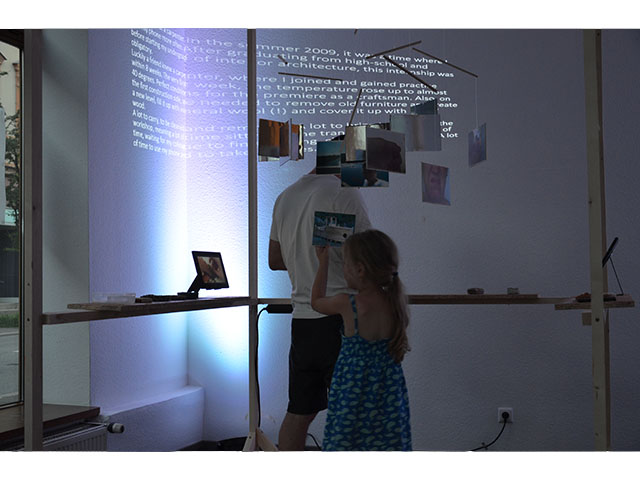Lisa Pusch
Master Thesis l Interim-Prof. Michael Markert l Interface Design, Bauhaus-Universität Weimar l Prof. Jordan Geiger l Situated Technologies Research Group, University at Buffalo l Summer 2015
MY MEMORY IS NOT YOUR MEMORY is the title of the implementation as part of the process of MEMORY PROBES. The implementation is part of Lisa Pusch‘s master thesis ON MEMORY: BODY, DEVICES, MATERIAL at Bauhaus-Universität Weimar, Germany and University at Buffalo, NY, USA.
In her thesis ON MEMORY: BODY, DEVICES, MATERIAL Lisa Pusch explores the fields of media arts, architecture theory and phenomenology as well as approaches like human centred design. her aim is to work towards a (new) practice of mediaarchitecture.
MY MEMORY IS NOT YOUR MEMORY
a scenic and narrative 1:1 installation is recreating and re-imagining the artist ‘s personal memories. By transforming them into a mobile of three different memories (place-related, time-related, activity-related), the visitor can observe and project in them. Fragments of memory such as real medias (photos / videos) and sensory retrievals build a kaleidoscopic image of the subjective memories. The backsides of the parts of the mobile are mirrored. so, the visitor looks at herself / himself: the focus of someone else’s memories shifts towards oneself. a shift within the concepts of objectivity and subjectivity.
Behind the wooden frame, the recalled memories are projected in words at the wall to create another level of reflection and perception, also with another medium. The structure holding the mobile also acts as a metaphor in itself: placed inside a shop-window it is visible from various positions and distances. These different distances refer to spatial-theoretical assumptions of real space, virtual space and memory space. Approaching the installation and finally entering it, the visitor more and more approaches the artist’s viewpoint. To even come closer to her viewpoint, the visitor can interact and re-act by “using” the model of the phones positioned on the sides of the installation.
Interacting through holding, touching or smelling (etc.) with the phones in another sensory way, the visitor relieves the subjective perspective of the artist and might get a feeling for her memories. Transforming the concrete memory from a subjective viewpoint into the shape of a carrier of mobile information, the models open up a discussion about our relation to mobile device.
THE CRAFTING MEMORY LAB
The second part of the exhibition invites the visitor to recall her / his
memory/ies by following the same steps the artist did to recall hers. By creating MEMORY ARTEFACTS and sharing them online in an archive like webpage, the multiplicity of subjective memories becomes obvious: A new level of art practice which can give new insights for the ongoing thesis research.
Instructions given to the visitors build the starting point for the contribution towards the thesis process. By crafting, the visitor is reflecting herself / himself and her / his memories to mobile devices in order to contribute to the archive.






